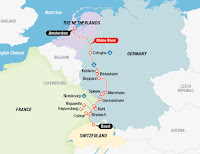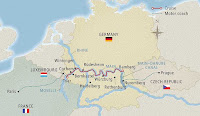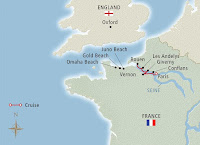One other distinction that I have come across between the really high-end Deluxe operators, and the mid-level First Class ones, is that it seems that the more money you pay, the more that they "take care of you". I don't necessarily mean this in a good way - i.e. It's nice to sometimes just strike out on your own after breakfast, or the included, one-hour walking tour in the morning. With the Deluxe operators, they seem to try and fill your day completely with the activities that they have planned for you (and indeed that you have paid a premium for), but that may not be how you wanted to spend your day. e.g. While going to the exclusive concert at the Schonbrunn Palace might sound fancy, maybe you really just wanted to wander around Vienna at night, sampling cocktails on the Stadtbahnbögen.
Make sure you understand the differences in fares between operators, and what is included vs. add-on extra prices. I often see air-inclusive offers, and then subtract the approximate value of the flight to arrive at a per-night average cost. Be aware that some operators will quote the total number of days for your excursion, including the day and overnight red-eye flight to Europe; e.g. a "9-day cruise" is sometimes only 7 nights of accommodation. So for the best apples-to-apples comparison, I will strip off the travel day/night, and then do a per night calculation.
Here's an example of a price comparison I'll do on a couple of discounted fares that I found today:
- Emerald Waterways - 8 day (Upper) Danube Explorer; on sale for $2,445 in Category B stateroom. It's a last minute deal for an August date, which is usually less desirable than later into September. $2,445 divided by 7 nights = $349 pp/night. But since Emerald includes all tips, I would knock this down to $325 pp/night for comparison.
- Gate 1 - 11 day Danube w/ Budapest; on sale for $2,599 in Category D stateroom for August 2020 on their deluxe ship. $2,599 divided by 9 nights = $288 pp/night. Factor in a few meals in Budapest while staying at the hotel for two nights, so let's call it ~$300 pp/night.
Knowing what these operators include, I would say that these are similar in terms of deal value. However, with some deal watching, and being over a year out, the Gate 1 price will probably go down further. We did the Gate 1 Danube cruise with Budapest
and Prague in May for $1,899. Divided by 12 nights, that was $158 pp/night!
2023 Update: I saw a recent deal from Gate 1 for the Danube including 3 nights in Munich for a late August 2023 sailing that came in at $170/night in a Cat D panorama stateroom, so these kinds of prices still come up!
Most Popular Routes
We've done three river cruises so far, and likely ended up taking these top ones due to their availability and special offers. i.e. When we we started looking around for deep discounts and sale prices, we quickly found which routes were consistently coming up, and which rivers did not have as many dates available. Plus, when we saw six Viking longships docked all together in Budapest, we knew that was a popular route!
 |
| Credit: gate1travel.com |
The Upper Danube River is either the top or second most popular route, specifically from
Budapest to Regensburg/Nuremburg. With a great option to do a post-extension in Prague, this is a five country tour, with fantastic stops along the way, it includes Bratislava, Vienna and Regensburg, and other hidden gems along the Danube. Most operators will cruise the beautiful Wachau Valley one morning, taking in stops at Durnstein and Melk along the way. With Budapest as a starting/ending point, this is a great way to get a taste of Central Europe. Most operators offer two extra days there, for pre/post-extension, and we recommend another three days in Prague.
We did the full Budapest to Prague trip with Gate 1, and had a great time! A set of videos created by Mat Cain illustrate the highlights along this route -
watch them here!
 |
| Credit: uniworld.com |
When you see pictures online of river cruises, you will often see the beautiful Middle Rhine Valley, featuring magnificent Medieval castles around every curve. It's no wonder that this is one of the most popular routes - from
Amsterdam to Basel, it takes you through the heart of the Alsace wine region, and sails through four countries in 7 days. If you want to try river cruising, then this is the top route we would recommend you try first; it was our first with Uniworld, and it hooked us! Amsterdam is a fantastic starting point for your journey (click
here for some video highlights), and we recommend at least two full days to explore; if your itinerary does not include it, do a pre-extension there. We recommend going upstream, as the Rhine gets more interesting going upriver.
 |
| Credit: gct.com |
While not one one river specifically, the springtime Tulips and Windmills cruise through
Belgium and Holland seems to be in the top three for most popular cruise. Embarking in Antwerp, most passengers will fly into Brussels, which is worth of a couple of days pre-extension. No Belgian visit would be complete without a day-trip to Bruges, a UNESCO heritage site. Visit the windmills in Kinderdijk (click
here for an amazing video), and of course, the colourful tulips at the Keukenhof Gardens. Disembarking in Amsterdam, passengers have another great opportunity to spend time strolling the canals or visiting the Rijksmuseum. This was our second river cruise, but first experience with Vantage, and we would definitely sail with them again!
Update: I wrote about this one here.
There are a number of cruise options in France;
Paris to Normandy is a popular trip, taking in the historic battlegrounds on the coast of Normandy, enjoying culinary delights along the Loire Valley, and of course, Paris. There are also a number of operators that run cruises North-South, down the
Seine or Rhone Rivers; judging by the number and frequency of tours, these are not as popular as the Paris-Normandy cruise however. Nonetheless, if you are a wine-lover, then these likely warrant a closer look.
 |
| Credit: Gate1travel.com |
Another route that sails less often, but has many unique countries and places to visit, is the
Lower Danube River. With Budapest as the typical embarkation point, it offers a great city to get over your jet lag before a seven or eight day cruise down the Danube towards the Black Sea. Disembarkation is usually in Romania, with a short coach ride to Bucharest for your flight home or extension.
We just did this itinerary with Emerald in 2022, and the cities and towns are not as exciting and interesting as say, the Rhine or upper Danube; I’d say pass on this one until you’ve done those two.
 |
| Credit: Viking river cruises |
If Germany is your thing, there is one route that sails the
Moselle and Main Rivers, and has stops in ports that are unique to this route. Viking offers an excellent option that starts with a few days in Paris, then takes a coach to Trier to embark on your cruise. You then traverse across Germany, ending near Nuremburg, and then coach again to extend for some time in Prague. Maybe a great one to try during Oktoberfest?
There are certainly other routes available to explore; this is only a handful of suggested rivers to sail on. Portugal's Douro River is offered by some operators, and there are Russian waterways if you would like to go further East. And then of course, there's something called the "Grand European Tour" offered by Viking that goes from Amsterdam to Budapest, but everyone has their version of it. At 14 days, this seems like a bit too much, in my opinion, for one cruise. By the end, you won't know what city or country your are in, with a new port-of-call each day. But if this is going to be your one and only trip to Europe, then you'll definitely see a lot in two weeks. Keep in mind that the more popular the route, the more likely that there are multiple river cruise operators vying for your business, and potentially offering better pricing.
Ship Layout and Room Categories
 |
| Palatial stateroom on the Gate 1 Monarch Queen. Credit: Gate1travel.com |
Virtually all river cruise ships have the same layout; three passenger room levels total, with between 70 and 100 rooms. The bottom deck will have the engine room, etc., along with a mix of crew quarters and passenger rooms. These rooms are usually the smallest at ~125 sq. ft., are sometimes outfitted for singles, and do not have the floor-to-ceiling windows, but instead have a small window that could be at eye level; as such, we don't select rooms on the bottom level. Be aware that most of those too-good-to-be-true prices quoted start on this level. For the second and third decks, the staterooms are mostly the same layout, slightly larger than the bottom deck (150 - 200 sq. ft.) and typically have floor-to-ceiling, wall-to-wall windows, often called Panorama Windows. These rooms essentially have sliding glass doors with a French Balcony. For more on the different types of balcony rooms,
click here. The third level will also have suites with rooms up to 400 sq. ft., featuring a sitting area and more luxurious interiors. The fourth level of course is where the open air lounge space can be found, along with things like a jogging track, and in rare instances, a pool.
 |
| Monarch Empress layout Credit: Gate1travel.com |
Most operators will divide their ship into 5 distinct categories or price levels (the naming might vary from line to line); the Cat E being the cheapest on the bottom level, Cat D and C on the middle deck with slight price advantage at the rear, then Cat B and A on the top passenger deck, with the pricier suites closer to the front. For all but the most budget-centric, we would recommend either the middle or top deck, depending on availability. Despite the variance in price, you will typically find that category A - D rooms are identical in size and appointments. We have cruised on both the middle and top level, and found no significant difference between them. But don't worry about being on the outside of the ship; all river cruise staterooms face out, and will have a window of some sort. While some travellers try to choose either the port or starboard side for the best views, we feel that it really doesn't matter which side you are on. Surprisingly, sometimes the last-minute deals offered are for the category A and B rooms; at the higher price for the standard room, they are often the last to go.
When to go?
If you are asking yourself when you should go, the first answer should be 'now'. Of course there are some cruises that are specifically tailored to one season or timeframe - e.g. Tulips and Windmills in spring, or the Christmas markets cruises. But there is always a warning about river water levels; too much spring runoff, and some ships can't make it under the low bridges. Or if the river level drops too low in the late summer, some ships can't sail down that route. It's worth considering these factors if you have the flexibility on your dates or routes; you can't do much about it if water levels do affect you, but you might want to reconsider that late August deal, as that's most likely when the rivers start to dry up. Surprisingly, the best deals I have seen are sometimes in the middle of summer, during the peak tourist season; river cruise operators know that most of their clientele don't have children (anymore), and they/we will naturally opt for the cooler shoulder seasons and avoid the summertime tourist crunch. Weather can be a challenge in April and November, but May and October are great for comfortable temperatures in most parts of Europe.
Regardless of what room, time of year, route or operator you choose, I am certain that river cruising will surely impress and delight you. We are certainly hooked, and are always looking for the next best deal. Edit: I found one!
Read about comparing prices in my new post here.
No endorsements or fees have been paid by tour operators or river cruise companies for this post.












